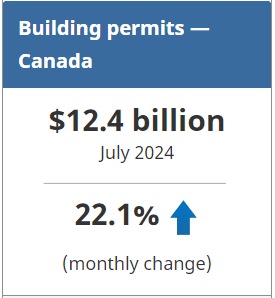![]()
Month over month, the total value of building permits in Canada surged 22.1% to $12.4 billion in July, rebounding from two consecutive monthly declines. Both the residential and non-residential sectors expanded in July.

On a constant dollar basis (2017=100), the total value of building permits in July was up 22.9% compared with the previous month, while it rose 3.4% year over year.
Multi-unit construction intentions fuel growth in the residential sector
The total monthly value of residential permits increased 16.7% to $7.6 billion in July. The gains were driven by the multi-unit component (+29.3%; +$1.1 billion), while single-family construction intentions saw a modest decline (-1.9%; -$50.3 million).
In July, the value of permits issued in the multi-unit component (+29.3%) increased substantially to $5.0 billion, its second-highest monthly level on record after an all-time high of $5.9 billion in April. British Columbia (+152.1%; +$766.8 million) led the increase, with significant contributions from the City of Richmond. Alberta (+33.1%; +$141.0 million) and Ontario (+7.7%; +$122.6 million) were also major contributors to the growth in the multi-unit component.
Across Canada, 20,700 new dwellings in multi-unit buildings and 4,100 new single-family dwellings were authorized in July. From August 2023 to July 2024, a total of 266,200 new units were authorized.
Ontario and British Columbia lead gains in non-residential construction intentions
The total value of non-residential sector permits rose 31.8% to $4.8 billion in July. Overall growth in this sector was seen across the commercial (+18.4% to $2.2 billion), industrial (+98.6% to $1.3 billion) and institutional (+14.8% to $1.3 billion) components.
In Ontario, the non-residential sector grew 23.8% to $2.2 billion in July, driven by gains in the industrial component (+99.3%; +$338.0 million). The large monthly gains in Ontario’s industrial component pushed the value to a record-high level of $678.3 million in July. This was supported by construction intentions for the expansion of a tire manufacturing plant in Greater Napanee and broad-based growth throughout the province.
In British Columbia, the non-residential sector increased 99.2% to $869.1 million in July, with large gains in the industrial (+349.2%; +$168.4 million), institutional (+383.0%; +$157.6 million) and commercial (+30.8%; +$106.8 million) components.
To explore data using an interactive user interface, visit the Building permits: Interactive Dashboard.
For more information on construction, please visit the Construction statistics portal.
For more information on housing, please visit the Housing statistics portal.
Note to readers
Unless otherwise stated, this release presents seasonally adjusted data with current dollar values, which facilitate month-to-month and quarter-to-quarter comparisons by removing the effects of seasonal variations. For information on seasonal adjustment, see Seasonally adjusted data – Frequently asked questions.
For information on trend-cycle data, see the page Trend-cycle estimates – Frequently asked questions.
Building components
- Single-family dwellings: Residential buildings containing only one dwelling unit (e.g., single-detached house, bungalow, linked home [linked at the foundation]).
- Multi-family dwellings: Residential buildings containing multiple dwelling units (e.g., apartment, apartment condominium, row house, semi-detached house).
- Industrial buildings: Buildings used in the processing or production of goods or related to transportation and communication.
- Commercial buildings: Buildings used in the trade or distribution of goods and services, including office buildings.
- Institutional and government buildings: Buildings used to house public and semi-public services, such as those related to health and welfare, education or public administration, and buildings used for religious services.
Revision
Data are subject to revisions based on late responses, methodological changes and classification updates. Unadjusted data have been revised for the previous month. Seasonally adjusted data have been revised for the previous three months.
Next release
Data on building permits for August will be released on October 11.
Source: Statistics Canada
